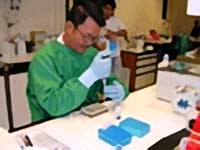Professor and Doctor Trần Văn Bé and his team at Ho Chi Minh City Blood Transfusion and Hematology Hospital have dedicated many years to researching this field, achieving significant and valuable work to date.
Quality Umbilical Cord Blood from Newborns
 |
Processing umbilical cord blood in the laboratory at Ho Chi Minh City Blood Transfusion and Hematology Hospital |
He has successfully standardized techniques for collecting umbilical cord blood from mothers immediately after childbirth, processing the blood for cryopreservation, and thawing it before transfusion to patients. Additionally, he screens the maternal blood prior to childbirth and the umbilical cord blood post-delivery for infectious diseases caused by viruses, bacteria, and more.
This achievement is regarded by the scientific community as a breakthrough in the treatment of malignant and genetic disorders in our country.
Professor and Doctor Trần Văn Bé explained that umbilical cord blood is obtained from the umbilical vein of the placenta immediately after birth. The process begins with clamping the umbilical cord at the fetal end within 15 seconds after delivery, disinfecting the umbilical cord, and using a syringe and needle to extract blood from the umbilical vein into a bag containing an anticoagulant solution, then preserving it with a 10% DMSO solution at a temperature of -196 degrees Celsius. This entire procedure must strictly adhere to sterile protocols.
Once collected, the umbilical cord blood unit must be tested to exclude infectious diseases such as viral hepatitis, syphilis, HIV, bacterial infections, as well as HLA typing and screening for potential congenital genetic disorders.
The most challenging aspect of this research is processing umbilical cord blood to meet transplantation standards, particularly during the isolation of CD34+ cells (a valuable factor in umbilical cord blood that aids grafting for bone marrow regeneration). The ultimate goal is to successfully cryopreserve the umbilical cord blood in liquid nitrogen, ensuring that the cell count remains intact after thawing.
Final results indicate that the number of CD34+ mononuclear cells is comparable to those in umbilical cord blood banks in Tokyo, Japan. The study at Ho Chi Minh City Blood Transfusion and Hematology Hospital shows that the post-processing cell recovery rate is 95.2%, which is considered very high.
Successful Transplantation of Umbilical Cord Blood for Patients
The processed hematopoietic stem cell product has been successfully transplanted into five patients, consisting of two males and three females aged 6 to 16, suffering from acute myeloid leukemia, acute lymphoblastic leukemia, and thalassemia. The transplantation is performed intravenously, and depending on the volume of umbilical cord blood, the duration of the procedure can range from 30 minutes to 4 hours.
Post-transplant, the patients who received umbilical cord blood samples produced in Ho Chi Minh City exhibited bone marrow growth times comparable to those receiving samples imported from the Tokyo bank.
In Ho Chi Minh City, the umbilical cord blood bank has been established for several years, with over 1,500 umbilical cord blood samples processed to standard and cryopreserved. In 2004, it was recognized by the Asia Cord Blood Association as an ASIA CORD standard bank. Consequently, Vietnam has become an official member of this international association. Currently, the Ho Chi Minh City Umbilical Cord Blood Bank has begun participating in a system for tracking and exchanging with banks in other Asian countries.
Major Barrier for Transplantation: $30,000!
The primary obstacle for the umbilical cord blood transplantation program in Vietnam is the high cost, which is approximately $30,000, compared to the average income of workers. In the future, if health insurance covers the expenses, more patients may have the opportunity to access this advanced technique.
Donors of umbilical cord blood must meet certain criteria: the mother must not have conditions like jaundice, hepatitis, nephritis, cardiovascular disease, mental illness, congenital genetic disorders, chronic diseases, or infectious diseases.
Blood pressure must be below 180 mmHg (systolic) and below 100 mmHg (diastolic), pulse 60-100 beats per minute, temperature below 38 degrees Celsius, and weight over 40 kg. The child must not have congenital defects or genetic disorders. Additionally, to avoid future complications, the mother must sign a commitment form waiving any complaints or requests post-donation.
————————————————–
Read more: Thai People Reserve Umbilical Cord Blood Abroad




















































